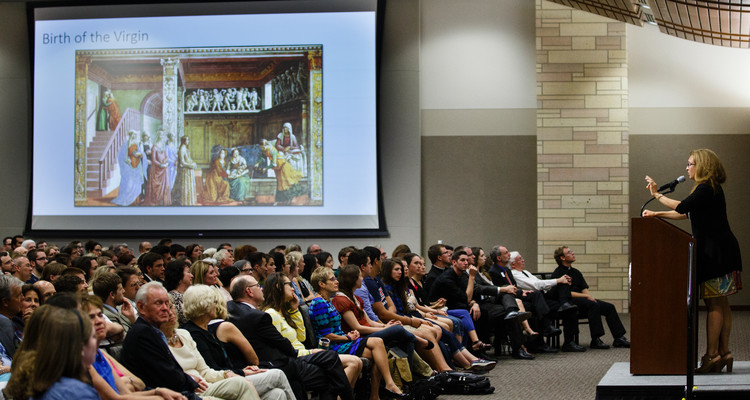Dr. Elizabeth Lev was an undergraduate student at the University of Chicago during an exciting time in art history, a time when the world of art was beginning to see Michelangelo with new eyes. During one of her classes, the professor brought in pictures of the early stages of the Sistine Chapel’s restoration. The newly restored Delphic Sybil glowed with color. Her professor announced, “We have to rethink Michelangelo.” This realization, that volumes were yet to be written about this great artist, opened a space for someone such as Lev, who was just entering the field of art history.
Lev currently lives in Rome, where she is a professor of art history. She teaches students from a variety of universities, including the University of St. Thomas. She has a deep appreciation for the Catholic Studies students who come to study in Rome.

Art history professor Elizabeth Lev delivers her speech on "Michelangelo's Women" Sept. 14, 2015, in the Anderson Student Center's Woulfe Alumni Hall.
“They can talk about deeper issues,” she said. “We explore how art fits in theologically and liturgically. It’s fascinating having seminarians in the group, because they can explain about how a work participates in the consecration.”
In addition to teaching, she serves as a tour guide and has hosted a television series on the art of the Vatican museums. She is author of The Tigress of Forli: Renaissance Italy’s Most Courageous and Notorious Countess, Caterina Riario Sforza de' Medici and co-author of Roman Pilgrimage: The Station Churches (with George Weigel) and A Body for Glory: Theology of the Body in the Papal Collections (with Father Jose Granados).
In mid-September, Lev visited St. Thomas. Her itinerary included lunch with St. Thomas president Dr. Julie Sullivan and a group of women interested in Catholic Studies, the University of St. Thomas and the arts, during which she shared her experiences as an art historian in Rome and her delight in teaching St. Thomas students. She also met with a number of students, including undergraduate Catholic Studies students and students from both the Art History and Catholic Studies graduate programs.
Dr. Victoria Young, chair of the Art History Department, said, “We appreciate the time Dr. Lev spent directly with students in group discussions, as it really gave them a chance to engage with her and her work.”
The highlight of Lev’s visit was her lecture, “Michelangelo’s Women: How the Renaissance Master Reinvented the Female Form,” presented to a packed audience of 450 persons Sept. 14*. The lecture, co-sponsored by Catholic Studies and the Art History Department, addressed the idea that Michelangelo’s women were limited to very muscular, almost mannish women or to mild-mannered Madonnas. As Lev explored the Sistine Chapel, she found an astonishing variety of women, including 22 mothers in pictures portraying Christ’s ancestry. Lev commented on the attention Michelangelo gave to these women, even though this section of his fresco was done rapidly. The women are shown with elaborate clothing and headdresses, and most are busy tending to children and household activities. Regarding Michelangelo’s muscular women, she noted that Michelangelo used extremely muscular bodies, both male and female, in “The Last Judgment” to represent saints who were morally strong and courageous.
“The Church sees in women a capacity to overcome opposition just as men can,” Lev said. Michelangelo’s women are a part of that tradition.
Dr. John Boyle, director of the MA program in Catholic Studies and manager of the Rome program, was struck anew during Lev’s talk with the way she sees the elements of the Sistine Chapel ceiling in relation to one another.
“She sees the movement of the whole and is able to articulate it so that we can, at least in part, participate in that vision of the whole,” he said. “That grasp of the whole in turn illuminates so many details in so many fascinating ways as we saw in the discussion of the surprising variety of presentations of women on the ceiling.”
While Lev’s talk presented a different view of Michelangelo’s approach to women, the book that she and Granados recently completed focuses on how the human body is portrayed first in the work of ancient civilizations – Egypt, Greece and Rome – and finally in Michelangelo’s work, particularly in “The Last Judgment.” Lev noted that part of what was interesting about the project that led to the book was the opportunity for an art historian and a theologian to work together.
Lev has been a popular professor with students who participate in the Catholic Studies Rome program. Her visit enabled those who have not been exposed to her work, as well as students and alumni who have had the opportunity to learn from her in the past, to benefit from her most recent insights into Michelangelo’s art, particularly his representations of women.
*View Elizabeth Lev’s talk here.
